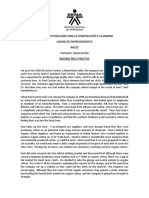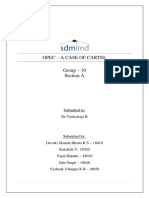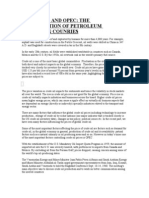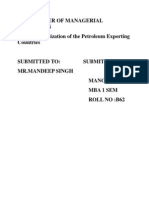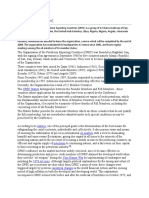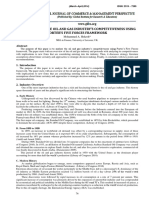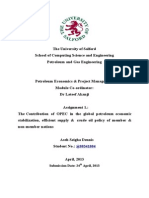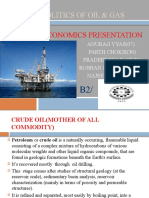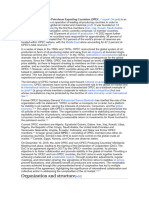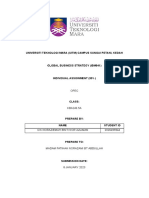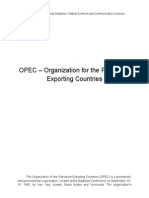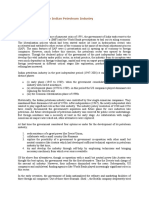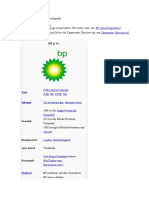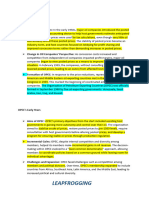Opec-Sandeep Prasad
Opec-Sandeep Prasad
Uploaded by
sandeep7162Copyright:
Available Formats
Opec-Sandeep Prasad
Opec-Sandeep Prasad
Uploaded by
sandeep7162Copyright
Available Formats
Share this document
Did you find this document useful?
Is this content inappropriate?
Copyright:
Available Formats
Opec-Sandeep Prasad
Opec-Sandeep Prasad
Uploaded by
sandeep7162Copyright:
Available Formats
Overview of History, Structure, Function of Organization of the Petroleum Exporting Countries (OPEC)
School of Petroleum Management, PDPU SANDEEP PRASAD Exe-MBA10 Roll No-20104005
OVERVIEW AND HISTORY-OPEC
Sandeep Prasad (20104005)
Table of Content
1.0 Introduction...3 2.0 Developments in Oil Industry...3 2.1.0 Phase I......3 2.2.0 Phase II...4 2.3.0 Phase III....4 2.4.0 Phase IV....5 3.0 Organization of the Petroleum Exporting Countries....7 3.1.0 Organization Principal Objectives..9 3.2.0 Phase of OPEC Development....9 4.0 Membership....13 5.0 Organization Structure..14 5.1.0 The Conference.....15 5.1.1 Function of Conference....16 5.2.0 The Board of Governer....17 5.2.1 Function of Board of Governer......18 5.3.0 The Secretariat.....18 5.3.1 Function of Secretariat....19 6.0 References.20
Page 2 of 20
OVERVIEW AND HISTORY-OPEC
Sandeep Prasad (20104005)
1.0
INTRODUCTION This report is intended to shed some light on the meaning of globalization, international oil market and market determination following the 1970s crises of restructuring in the oil industry. It traces the changes in the organizational pattern of this industry over time and highlights the nature of market interactions in these industries. The focus here is upon the Organization of Petroleum Exporting Countries (OPEC) whose characteristic and action has been the subject of ad hoc and often contradictory interpretation by the economists, historians, political scientists, and indeed journalists. At the more popular level, though, OPEC has been rendered synonymous with the word cartel in the minds of most policy makers and politicians, and been the subject of uncritical, if not sensational, rhetoric of the news media today.
2.0
DEVELOPMENTS IN OIL INDUSTRY
Oil was discovered by Colonel Drake and William A. Smith in 1859. The oil industry has undergone four distinct phases between 1859 and 1960, when OPEC was formed. Here a brief description of the pre-OPEC era is given.
2.1.0
Phase I: Oil Rush and Competition (1859-1870)
The discovery of oil triggered an oil rush in America as fortune seekers rushed to the site to buy land and construct oil derricks. As the American law confers the ownership of the underground resources to the landowner, there
Page 3 of 20
OVERVIEW AND HISTORY-OPEC
Sandeep Prasad (20104005)
is an enormous incentive to pump oil from the ground as fast as possible, so as to surprise the neighbor. With a low recovery rate (about 5% at that time), this rush led to excessive drilling and a considerable wastage. Moreover, every time a significant new field is discovered, prices fell and output soared. Prices sometimes varied even 100 times during this period. The industry was essentially an American industry.
2.2.0
Phase II: Between 1870 and 1911
During this phase, John D. Rockefeller dominated the oil industry. He entered the refining business in 1863 in Cleveland Ohio His strategy was to gain control of the industry by controlling the bottleneck facilities such as the refining, transportation and distribution segments of the industry. Rockefeller and his assistant Henry Flagler set up the Standard Oil Company in 1870. Standard Oil became larger than its competitors through economies of scale and could influence the producer prices and the output prices using its market power. But the changes to the legal and regulatory frameworks proved to be the most important threat to Standard Oil. The passage of Sherman Antitrust Act of 1890 and the subsequent proceedings against the company ultimately led to the dissolution of Standard Oil. In accordance with the Court order, Standard Oil was divided into several separate entities
Page 4 of 20
OVERVIEW AND HISTORY-OPEC
Sandeep Prasad (20104005)
2.3.0
Phase III: Internationalization of Oil Industry (19111928)
During this period, oil started to displace coal as the dominant fuel in the world economy. The maturity of the automobile industry spurred demand for gasoline and the break out of the First World War fuelled oil demand for military and other services.
Industrialized economies realized their increasing dependence on oil after World War I and even there was concern about rapid depletion of the American oil reserves. As a response, oil companies started to invest in new crude oil production, which in turn led to a glut in world oil supplies by 1928 and a drastic fall in prices. In an attempt to stabilize the market, three leading oil companies, namely Standard oil of New Jersey, Royal Dutch/Shell and Anglo-Persian, decided to minimize competition and organize the market. The American market was excluded from these agreements.
2.4.0
Phase IV: Between 1928 and 1960
During this period, a number of major developments took place that changed the face of the oil industry. These include:
The Middle East started to emerge as the focal point of all attention due to its huge reserve potential. The importance of oil continued to grow and in the Second World War, oil played an important role.
Page 5 of 20
OVERVIEW AND HISTORY-OPEC
Sandeep Prasad (20104005)
The USA became a net importer of oil in this phase and this required a change in the pricing policy to ensure competitive oil supplies from the Middle East.
Adjustment to the pricing became important in 1948 to allow an expansion of the Middle Eastern supply. This was done by introducing a posting price using Middle East price. The competition from the Middle East also brought new issuesAmerican administration became concerned with the rising import dependence. The American government reacted by imposing import quotas in 1959.However, since 1956 international companies started to apply a new systemthe posted price. Here, prices for crude and products were posted: crude postings were fob well head excluding gathering and collection costs whereas product postings were fob refinery. These are buyer-set prices and were used as the reference price for tax and royalty determination. Yet, realized prices were different from posted prices as various discounts on posted pricesof the order of 2030%were offered. Such discounts included cash discounts, long term commitment discountsto reflect reduced risk on the producer and large order discountsto reflect reduced handling charges. There was a growing sentiment that the pricing policy eroded the value of the Middle Eastern oil and served the interests of the importing countries. The producing countries therefore decided to work together to protect their own oil interests which lead to OPEC.
Page 6 of 20
OVERVIEW AND HISTORY-OPEC
Sandeep Prasad (20104005)
3.0
ORGANIZATION OF THE PETROLEUM EXPORTING COUNTRIES OPEC was formed in response to the declining crude posted prices, imposed. OPEC is a permanent intergovernmental organization was established in Iraq in September 1960 by five leading oil producing states (Iran, Iraq, Kuwait, Saudi Arabia and Venezuela) and was registered with United Nations Secretariat on November 6, 1962 in an attempt to co-ordinate petroleum policies of member states so as to secure a fair and stable remuneration for their outputs. Currently OPEC consisting of 12 oil producing and exporting countries spread across three continents America, Asia and Africa. The members are Algeria, Angola, Ecuador, Iran, Iraq, Kuwait, Libya, Nigeria, Qatar, Saudi Arabia, UAE and Venezuela. These countries have a population of more than 399 million and for nearly all of them oil is the main marketable commodity and foreign exchange earner. Thus for these countries oil is the vital key to development-economic, social and political. Their oil revenues are used not only to expand their economic and industrial base, but also to provide their people with jobs, education, health care and decent standard of living.
Page 7 of 20
OVERVIEW AND HISTORY-OPEC
Sandeep Prasad (20104005)
Table1. OPEC MEMBER COUNTRIES:
Country Algeria Angola Ecuador IR Iran * Iraq * Kuwait * SP Libyan AJ Nigeria Qatar Saudi Arabia * United Arab Emirates Venezuela*
*Founder Members Source:
Joined OPEC 1969 2007 rejoined 2007 1960 1960 1960 1962 1971 1961 1960 1967 1960
Location Africa Africa South America Middle East Middle East Middle East Africa Africa Middle East Middle East Middle East South America
1971
Fig 1. OPEC Member Countries Source: visitbulgaria.info
Page 8 of 20
OVERVIEW AND HISTORY-OPEC
Sandeep Prasad (20104005)
3.1.0
The organizations principal objectives are:
1. To co-ordinate and unify the petroleum policies of the member Countries and to determine the best means for safeguarding their individual and collective interests; 2. To seek ways and means of ensuring the stabilization of prices in international oil markets, with a view to eliminating harmful and unnecessary fluctuations and ; 3. To provide an efficient economic and regular supply of petroleum to consuming nations and a fair return on capital to those investing in the petroleum industry.
3.2.0
Phase of OPEC Development
The phase of development can be split into a number of phases: A. The 1960s OPEC developed its collective vision, set up its objectives and established its Secretariat, first in Geneva and then in 1965, in Vienna. It adopted a Declaratory Statement of Petroleum Policy in Member Countries in 1968 which emphasized the inalienable right of all countries to exercise permanent sovereignty over their natural resources in the interest of their national development. Membership grew to ten by 1969.
Page 9 of 20
OVERVIEW AND HISTORY-OPEC
Sandeep Prasad (20104005)
During this initial phase, OPEC members focused on three areas of activity: tax system changes, production control and steps towards nationalization of concessions. Until OPEC gained price fixing power, short term objective was to maximize the share of producers surplus by reducing tax deductions. This was achieved by disallowing marketing allowance, expensing royalties and increasing tax reference price. Production control program started in 1965 but was abandoned in 1967. A system of maximum annual growth rates in export of members was fixed but did not work. The 1968 Manifesto encouraged creation of national oil companies to develop oil reserves, and national participation in concessions by purchasing of operating concessions as well as development of relinquished concessions. As the producing countries had to rely on the international companies to sell their oil, an arrangement of buy back by oil companies was designed. B. The 1970s OPEC rose to international prominence during this decade, as its Member countries took control of their domestic petroleum industries and acquired a major say in the pricing of crude oil on world markets. In 1971, OPEC opened negotiations with companies on a 5 year pact and forced a price increase of 21% for Saudi light, an increase in tax rate from 50 to 55% and an escalation of 2.5% in prices per year for inflation. Following the war in 1973, Arab producers imposed oil embargo and outbreak of the Iranian Revolution in 1979, oil price rose steeply on both the occasion. OPEC broadened its mandate with the first summit of Heads of State and Government in Algiers in 1975, which addressed the plight of the poorer
Page 10 of 20
OVERVIEW AND HISTORY-OPEC
Sandeep Prasad (20104005)
nations and called for a new era of cooperation on international relations, in the interests of world economic development and stability. This led to the establishment of OPEC Fund for International Development in 1976. C. The 1980s OPECs share of the smaller oil market fell heavily and its total petroleum revenue dropped below a third of earlier peaks, causing severe economic hardship for many Member Countries. Prices rallied in the final part of the decade, but to around half the levels of the early part, and OPECs share of newly growing world output began to recover. This was supported by OPEC introducing a group production ceiling divided among Member Countries and a Reference Basket for pricing, OPEC decided to fix $34 per barrel price. To achieve this, a 10% reduction in production in 1981 was initiated and Saudi Arabia decided an upper limit of 8.5 Mbd for Aramco in 1982. Production quota was introduced for the first time in March 1982. The market share of OPEC members declined rapidly to 20% from a high of above 50% in 1973. From 4.9 Million barrels per day (Mbd) in the second quarter of 1984 Saudi reduced its output to 2.3 Mbd in the third quarter of 1985, while non-OPEC producers filled the market. However, against this background of falling market share and declining prices, discontent increased among members. OPEC members decided to regain market share and a price war began. D. The 1990s Prices moved less dramatically than in the 1970s and 1980s, and timely OPEC action reduced the market impact of Middle East hostilities in 199091. But excessive volatility and general price weakness dominated the decade, and
Page 11 of 20
OVERVIEW AND HISTORY-OPEC
Sandeep Prasad (20104005)
the South-East Asian economic downturn and mild Northern Hemisphere winter of 199899 saw prices back at 1986 levels. During this period, OPEC worked through quota adjustments and supply adjustments. This helped maintain a reasonable price level for oil (between $15 and $20 per barrel).OPEC market share improved although non-OPEC share continued to dominate the supply. Such a situation encouraged members to produce beyond their quotas and OPEC was not able to ensure strict adherence to its quota policy. E. The 2000s An innovative OPEC oil price band mechanism helped strengthen and stabilise crude prices in the early years of the decade. But a combination of market forces, speculation and other factors transformed the situation in 2004, pushing up prices and increasing volatility in a well-supplied crude market. Prices soared to record levels in mid-2008, before collapsing in the emerging global financial turmoil and economic recession. OPEC became prominent in supporting the oil sector, as part of global efforts to address the economic crisis. OPECs second and third summits in Caracas and Riyadh in 2000 and 2007 established stable energy markets, sustainable development and the environment as three guiding themes, and it adopted a comprehensive long-term strategy in 2005.
Page 12 of 20
OVERVIEW AND HISTORY-OPEC
Sandeep Prasad (20104005)
4.0
MEMBERSHIP
A.
Founder Members of the Organization are those countries which were
represented at the First Conference, held in Baghdad, and which signed the original agreement of the establishment of the Organization.
B.
Full Members shall be the Founder Members, as well as those countries
whose application for membership has been accepted by the Conference.
C. Any other country with a substantial net export of crude petroleum, which has fundamentally similar interests to those of Member Countries, may become a Full Member of the Organization, if accepted by a majority of threefourths of Full Members, including the concurrent vote of all Founder Members.
D.
A net petroleum-exporting country, which does not qualify for
membership under paragraph C above, may nevertheless be admitted as an Associate Member by the Conference under such special conditions as may be prescribed by the Conference, if accepted by a majority of three-fourths, including the concurrent vote of all Founder Members. No country may be admitted to Associate Membership which does not fundamentally have interests and aims similar to those of Member Countries.
Page 13 of 20
OVERVIEW AND HISTORY-OPEC
Sandeep Prasad (20104005)
5.0
ORGANIZATION STRUCTURE
OPEC CONFERENCE
BOARD OF GOVERNER
SECRETARY GENERAL
Fig 2. Org. structure Source: OPEC
Page 14 of 20
OVERVIEW AND HISTORY-OPEC
Sandeep Prasad (20104005)
The Organization of the Petroleum Exporting Countries has three organs which are discussed below in brief:
5.1.0
THE CONFERENCE The Conference shall be the supreme authority of the Organization. The Conference made up of high level representatives of the government member, which meets twice a year. However, an Extraordinary Meeting of the Conference may be convened at the request of a Member Country by the Secretary General, after consultation with the President and approval by a simple majority of the Member Countries. The delegation may consist of one or more delegates, as well as advisers and observers. When a delegation consists of more than one person, the appointing country shall nominate one person as the Head of the Delegation. During the meeting deliberations take the following procedures. A. Each Member Country should be represented at all Conferences; however, a quorum of three-quarters of Member Countries shall be necessary for holding a Conference. B. Each Full Member Country shall have one vote. All decisions of the Conference, other than on procedural matters, shall require the unanimous agreement of all Full Members. C. The Conference Resolutions shall become effective after 30 days from the conclusion of the Meeting, or after such period as the Conference may
Page 15 of 20
OVERVIEW AND HISTORY-OPEC
Sandeep Prasad (20104005)
decide unless, within the said period, the Secretariat receives notification from Member Countries to the contrary. D. In the case of a Full Member being absent from the Meeting of the Conference, the Resolutions of the Conference shall become effective unless the Secretariat receives a notification to the contrary from the said Member, at least ten days before the date fixed for publication of the Resolutions. E. A non-Member country may be invited to attend a Conference as Observer, if the Conference so decides.
5.1.1
FUNCTION OF THE CONFERENCE A. Formulation of the general policy of the Organization and determine the appropriate ways and means of its implementation; B. Decide upon any application for membership of the Organization; C. Confirm the appointment of Members of the Board of Governors; D. Direct the Board of Governors to submit reports or make recommendations on any matters of interest to the Organization; E. Consider, or decide upon, the reports and recommendations submitted by the Board of Governors on the affairs of the Organization;
Page 16 of 20
OVERVIEW AND HISTORY-OPEC
Sandeep Prasad (20104005)
F. Consider and decide upon the Budget of the Organization, as submitted by the Board of Governors; G. Consider and decide upon the Statement of Accounts and the Auditors Report, as submitted by the Board of Governors; H. Call a Consultative Meeting for such Member Countries, for such purposes, and in such places, as the Conference deems fit; I. Approve any amendments to this Statute; J. Appoint the Chairman of the Board of Governors and an Alternate Chairman; K. Appoint the Secretary General; and L. Appoint the Auditor of the Organization for duration of one year. 5.2.0 THE BOARD OF GOVERNORS A. The Board of Governors shall be composed of Governors nominated by the Member Countries and confirmed by the Conference. B. Each Member of the Organization should be represented at all Meetings of the Board of Governors; however, a quorum of two thirds shall be necessary for the holding of a Meeting. C. The term of office of each Governor shall be two years.
Page 17 of 20
OVERVIEW AND HISTORY-OPEC
Sandeep Prasad (20104005)
5.2.1
FUNCTION OF THE BOARD OF GOVERNORS A. Direct the management of the affairs of the Organization and the implementation of the decisions of the Conference; B. Consider and decide upon any reports submitted by the Secretary General; C. Submit reports and make recommendations to the Conference on the affairs of the Organization; D. Draw up the Budget of the Organization for each calendar year and submit it to the Conference for approval; E. Nominate the Auditor of the Organization for a duration of one year; F. Consider the Statement of Accounts and the Auditors Report and submit them to the Conference for approval; G. Approve the appointment of Directors of Divisions and Heads of Departments, upon nomination by Member Countries, due consideration being given to the recommendations of the Secretary General; H. Convene an Extraordinary Meeting of the Conference; and I. Prepare the Agenda for the Conference.
5.3.0
THE SECRETARIAT The Secretariat of the Organization consists of the Secretary General and Staff. It functions at the Headquarters of the Organization. The Secretary
Page 18 of 20
OVERVIEW AND HISTORY-OPEC
Sandeep Prasad (20104005)
General is the legally-authorized representative of the Organization. The Conference appoint the Secretary General for a period of three years, which term of office may be renewed once for the same period of time. This appointment shall take place upon nomination by Member Countries. The Secretary General is a national of one of the Member Countries of the Organization.
5.3.1
FUNCTION OF THE SECRETARIAT A. Organize and administer the work of the Organization; B. Ensures that the functions and duties assigned to the different departments of the Secretariat are carried out; C. Prepare reports for submission to each Meeting of the Board of Governors concerning matters which call for consideration and decision; D. Inform the Chairman and other Members of the Board of Governors of all activities of the Secretariat, of all studies undertaken and of the progress of the implementation of the Resolutions of the Conference.
The Secretary General of the organization, also coordinate activities of other departments. The other departments are: Internal Auditor, Legal Office, Research Division, Data Service department (DSD), Petroleum Service department (PSD), Energy Service Dept (ESD), PR &Information Dept (PRID), Finance and HR Dept (FHRD), Administration and IT Service Dept.(AITSD)
Page 19 of 20
OVERVIEW AND HISTORY-OPEC
Sandeep Prasad (20104005)
6.0
REFERENCES
1. http://www.opec.org/opec_web/en/about_us/24.htm 2. http://www.opec.org/opec_web/en/about_us/26.htm 3. http://www.opec.org/opec_web/static_files_project/media/downloads/ab out_us/OPECORGANIGRAM.pdf 4. http://www.opec.org/opec_web/static_files_project/media/downloads/pu blications/OS.pdf 5. http://www.scribd.com/doc/24319278/OPEC%E2%80%99SORGANIZATIONAL-STRUCTURES-ITS-STRATEGIC-AIMS-OBJECTIVESPRODUCTION-QUOTA-INCOHESION-WITHIN-OPEC 6. http://www.liveoilprices.co.uk/crude_oil/the_history_of_crude_oil.html 7. http://www.econlib.org/library/Enc/OPEC.html 8. http://www.bp.com/liveassets/bp_internet/globalbp/globalbp_uk_english/ reports_and_publications/statistical_energy_review_2008/STAGING/local_ assets/2010_downloads/statistical_review_of_world_energy_full_report_2 010.pdf
Page 20 of 20
You might also like
- Porters Five Force On U.A.EDocument15 pagesPorters Five Force On U.A.ESai Vasudevan50% (2)
- Reading Skills PracticeDocument4 pagesReading Skills PracticeJesus Ovalle LievanosNo ratings yet
- OPEC-Document16 pagesOPEC-arilio0513No ratings yet
- Opec - A Case of Cartel Group - 10 Section A: Submitted To: DR - Venkatraja BDocument13 pagesOpec - A Case of Cartel Group - 10 Section A: Submitted To: DR - Venkatraja Brishab9sanghiNo ratings yet
- Historical Background of Oil Industry, World Supply-Demand: OPEC (Organization of Petroleum Exporting Countries)Document20 pagesHistorical Background of Oil Industry, World Supply-Demand: OPEC (Organization of Petroleum Exporting Countries)smelihatesNo ratings yet
- OPEC - Research Paper For MENADocument12 pagesOPEC - Research Paper For MENAArchil Kublashvili100% (2)
- Mba Project On OpecDocument65 pagesMba Project On Opecmukesh_saroj0070% (1)
- Oil Prices and OpecDocument11 pagesOil Prices and OpecPriya Bhatter0% (1)
- Term Paper of Managerial Economics OPEC: Organization of The Petroleum Exporting CountriesDocument14 pagesTerm Paper of Managerial Economics OPEC: Organization of The Petroleum Exporting CountriesAnnu SharmaNo ratings yet
- International Oil MarketDocument15 pagesInternational Oil MarketAniruddha MandalNo ratings yet
- International Oil Market-Final - Part One FinalDocument26 pagesInternational Oil Market-Final - Part One FinalMora MikhailNo ratings yet
- Organization of Petroleum Exporting Countries: Name: Shreya RachhDocument27 pagesOrganization of Petroleum Exporting Countries: Name: Shreya RachhShreya RachhNo ratings yet
- Econometric Models For Oil PriceDocument16 pagesEconometric Models For Oil PricedanonninoNo ratings yet
- Fundamental Analysis Final 2Document22 pagesFundamental Analysis Final 2Supriya Rai GoyalNo ratings yet
- OPECDocument2 pagesOPECAshish VermaNo ratings yet
- S6 Lectura1bDocument2 pagesS6 Lectura1bherve.ogou01No ratings yet
- Oil & Gas HandbookDocument126 pagesOil & Gas HandbookAlexis Gonzalez100% (2)
- OPEC - WikipediaDocument35 pagesOPEC - WikipediaAbbas GhulamNo ratings yet
- Organization of The Petroleum Exporting Countries (OPEC) HistoryDocument11 pagesOrganization of The Petroleum Exporting Countries (OPEC) HistoryDein RonalynNo ratings yet
- CS - OPEC CartelDocument4 pagesCS - OPEC Cartelroshansv23No ratings yet
- OpecDocument71 pagesOpecraj bhutiyaNo ratings yet
- Presented By: Gautam Ahuja Chemical, 4 YR, 1207535: Submitted To: Dr. BodhrajDocument15 pagesPresented By: Gautam Ahuja Chemical, 4 YR, 1207535: Submitted To: Dr. BodhrajgautamahujaNo ratings yet
- Saudi Arabian Experience and What Is Needed in The 21 CenturyDocument45 pagesSaudi Arabian Experience and What Is Needed in The 21 CenturyOdi InegbenijieNo ratings yet
- Report - 53915778 - Oil Politics and CurrencyDocument13 pagesReport - 53915778 - Oil Politics and CurrencyKavONo ratings yet
- OPEP5Document9 pagesOPEP5Cássio MagalhãesNo ratings yet
- (Enter Post Title Here) : OPEC StatuteDocument3 pages(Enter Post Title Here) : OPEC StatuteGodson Oluwaseyi AjayiNo ratings yet
- Oil and Gas Industry PDFDocument7 pagesOil and Gas Industry PDFGabriela MaerskNo ratings yet
- SPE 92888 OPEC: Floating Supply For A Balanced & Stable Market, Part IDocument6 pagesSPE 92888 OPEC: Floating Supply For A Balanced & Stable Market, Part Imsmsoft90No ratings yet
- Historical Background of Anatomy Od Crude OilDocument16 pagesHistorical Background of Anatomy Od Crude OilAlberto Hoyos ValeraNo ratings yet
- Opec AssignmentDocument10 pagesOpec AssignmentAmir O. Osho0% (1)
- CompositionDocument22 pagesCompositionPadma BhushanNo ratings yet
- Be (Opec)Document11 pagesBe (Opec)Kailash NarayanNo ratings yet
- New Seven Sisters: Group 3: Abhishek Kumar Anuj Malviya Mohit Kapoor Ravi Dudeja Stuti SethiDocument33 pagesNew Seven Sisters: Group 3: Abhishek Kumar Anuj Malviya Mohit Kapoor Ravi Dudeja Stuti SethiMohit KapoorNo ratings yet
- OPEKDocument2 pagesOPEKzoka_o831976No ratings yet
- Opec PDFDocument32 pagesOpec PDFShiva Konar100% (1)
- Opec - IfDocument19 pagesOpec - IfReshma LalaNo ratings yet
- Brief History of OPECDocument4 pagesBrief History of OPECRaji Rafiu BoyeNo ratings yet
- Lecture 1 GeoPolitics (word)Document15 pagesLecture 1 GeoPolitics (word)nishkalchagwestNo ratings yet
- Tijhss,+35 +HS1506-067Document9 pagesTijhss,+35 +HS1506-067farzanaNo ratings yet
- Crude Oil & GeopoliticsDocument31 pagesCrude Oil & Geopoliticsbhayaji007No ratings yet
- OPEP4Document2 pagesOPEP4Cássio MagalhãesNo ratings yet
- Research Paper - Oil Crisis in The 21ST CenturyDocument6 pagesResearch Paper - Oil Crisis in The 21ST CenturyAdil VasudevaNo ratings yet
- Individual Assignment Ibm641Document12 pagesIndividual Assignment Ibm641Cik NoraziemahNo ratings yet
- OPEC - Organization For The Petroleum Exporting CountriesDocument7 pagesOPEC - Organization For The Petroleum Exporting CountriesMariatoma1991No ratings yet
- Globalisation and Indian Petroleum SectorDocument6 pagesGlobalisation and Indian Petroleum SectorishtiaqrasoolNo ratings yet
- Navigation SearchDocument7 pagesNavigation SearchPrerna JoshiNo ratings yet
- OPEC - Committee BriefDocument3 pagesOPEC - Committee BriefMyiesha DawoodNo ratings yet
- Minicase On Supply DemandDocument4 pagesMinicase On Supply DemandRohan Sahni0% (1)
- Insight 68 A Comparative History of Oil and Gas Markets and Prices PDFDocument22 pagesInsight 68 A Comparative History of Oil and Gas Markets and Prices PDFManuel SantillanNo ratings yet
- OPECDocument20 pagesOPECSAURAV KUMAR VERMANo ratings yet
- GJCMP PorterDocument8 pagesGJCMP PortersultanthakurNo ratings yet
- MBA(G_B&F)_II_Economics for Management_outDocument3 pagesMBA(G_B&F)_II_Economics for Management_outNitin YadavNo ratings yet
- Blood and OilDocument8 pagesBlood and OilYUviNo ratings yet
- Projecteco 150828105238 Lva1 App6891Document15 pagesProjecteco 150828105238 Lva1 App6891Homam MohammadNo ratings yet
- Presentation Report IRE4112Document3 pagesPresentation Report IRE4112sweet.kristen99No ratings yet
- Porters Five Force On U A EDocument15 pagesPorters Five Force On U A EadildastiNo ratings yet
- Project Manisha StatDocument29 pagesProject Manisha StatShubham SainiNo ratings yet
- An Analysis of The Oil and Gas Industrys Competitiveness Using Porters Five Forces FrameworkDocument8 pagesAn Analysis of The Oil and Gas Industrys Competitiveness Using Porters Five Forces FrameworkSarasevina AnggraeniNo ratings yet
- How To Trade Oil PDFDocument12 pagesHow To Trade Oil PDFNil DorcaNo ratings yet
- Australia Oil AgeDocument26 pagesAustralia Oil AgeenjoygurujiNo ratings yet
- How To Outright Cancel 100 of Your Unsecured Debt Rev 2018 05 21 PDFDocument50 pagesHow To Outright Cancel 100 of Your Unsecured Debt Rev 2018 05 21 PDFJoshua of courseNo ratings yet
- Colliers Webinarreal EstateDocument54 pagesColliers Webinarreal EstateOktafia HariniNo ratings yet
- Catálogo Made in TepitoDocument45 pagesCatálogo Made in TepitoLuis JimenezNo ratings yet
- Download Full Property Tax Planning 17th Edition Khilji PDF All ChaptersDocument81 pagesDownload Full Property Tax Planning 17th Edition Khilji PDF All Chapterstwietdonezqa100% (2)
- The Impact of Traffic CongestionDocument3 pagesThe Impact of Traffic CongestionQuentin YapNo ratings yet
- Solving Problems Involving Simple InterestDocument28 pagesSolving Problems Involving Simple InterestCarbon Copy67% (3)
- Land Revenue SystemDocument9 pagesLand Revenue SystemRonakNo ratings yet
- 1 347294380652 - 2019 03 14 - 1Document19 pages1 347294380652 - 2019 03 14 - 1SiddiqueJoiyaNo ratings yet
- Sonnenschein A600 SolarDocument3 pagesSonnenschein A600 SolarlujalojoNo ratings yet
- CX NRTDocument1 pageCX NRTsenuranchalakaNo ratings yet
- Money Growth and InflationDocument45 pagesMoney Growth and Inflationguru110No ratings yet
- athenian-shipbrokers-NOV 2010Document17 pagesathenian-shipbrokers-NOV 2010Nguyen Le Thu HaNo ratings yet
- 1.2 Types of OrganizationsDocument34 pages1.2 Types of OrganizationsLUIS JEANPIER MARTINEZNo ratings yet
- 2208238376Document1 page2208238376NEW GENERATIONSNo ratings yet
- Orthoteks USA (A Case Study Analysis) : Sita Kasinath Jayaprakash RajeeshDocument8 pagesOrthoteks USA (A Case Study Analysis) : Sita Kasinath Jayaprakash RajeeshRajeesh RaghunathanNo ratings yet
- Adayinthelifeofa Professional Forex Trader: Defining Market HoursDocument3 pagesAdayinthelifeofa Professional Forex Trader: Defining Market HoursRich BoyNo ratings yet
- The Battle in Seattle (Reaction Paper) : Martes, John Cris C. Blis - 2ADocument2 pagesThe Battle in Seattle (Reaction Paper) : Martes, John Cris C. Blis - 2ASwarchzen Pacday DelizoNo ratings yet
- Statement of CM Jayalalitha After Releasing Tamil Nadu Vision 2023Document4 pagesStatement of CM Jayalalitha After Releasing Tamil Nadu Vision 2023kayalonthewebNo ratings yet
- 23GK0058Document5 pages23GK0058Engr'Shemaiah JimenezNo ratings yet
- KPDS 2002 KasimDocument17 pagesKPDS 2002 KasimRacingGuyNo ratings yet
- Draft (4) Eurogroup Statement On GreeceDocument2 pagesDraft (4) Eurogroup Statement On GreecePaul Mason100% (2)
- Homework Assignment 2.: Hint: Use The Standard Deviation of The Sales DataDocument2 pagesHomework Assignment 2.: Hint: Use The Standard Deviation of The Sales DataChux AnthonyNo ratings yet
- Nifty Options IntradayDocument65 pagesNifty Options Intradayswapnil koreNo ratings yet
- Zain Books and Uniform FeeDocument2 pagesZain Books and Uniform FeezeenatkerawalaNo ratings yet
- Preacher, Lawyer, Salesman SpeechDocument4 pagesPreacher, Lawyer, Salesman SpeechCut Farisa MachmudNo ratings yet
- 0217 Form NewDocument2 pages0217 Form NewJuanbon Padadawan100% (3)
- Group 1 - Activity-Based CostingDocument20 pagesGroup 1 - Activity-Based Costingchristian ReyesNo ratings yet
- Chapter 1 Introduction To The Financial SystemDocument39 pagesChapter 1 Introduction To The Financial Systemmohamed dahir AbdirahmaanNo ratings yet
- Nomad Capitalist - How To Reclaim Your Freedom With Offshore Bank Accounts - Dual Citizenship - Foreign Notebook PDFDocument9 pagesNomad Capitalist - How To Reclaim Your Freedom With Offshore Bank Accounts - Dual Citizenship - Foreign Notebook PDFEdwardLorenz0% (1)

